European Theatre of World War II

Animation of the WWII European Theatre. (Maps of the front at two-week intervals July 1943 to August 1945 available here)
|
||||||
|
||||||
The European Theatre of World War II was a huge area of heavy fighting across Europe from Germany's invasion of Poland on September 1, 1939 until the end of the war with the German unconditional surrender on May 8, 1945 (V-E Day). The Allied forces fought the Axis powers in three sub-theatres: the Eastern Front, the Western Front, and the Mediterranean Theatre.
Preceding events
Germany was defeated in World War I, and the Treaty of Versailles placed punitive conditions on the country, including significant financial reparations, the loss of territory (some only temporarily), war guilt, military weakening and limitation, and economic weakening. Germany was humiliated in front of the world and had to pay very large war reparations. Many Germans blamed their country's post-war economic collapse and hyperinflation on the treaty's conditions. These resentments contributed to the political instability which made it possible for Adolf Hitler and his National Socialist Party to come to power, with Hitler's appointment as Chancellor of Germany.
Meanwhile, in Italy, fascist party leader Benito Mussolini came to power as Prime Minister of Italy in 1923, after the March on Rome had turned the country into a fascist state and overthrew the government. Both leaders and parties had a strong sense of nationalism and turned their respective countries into totalitarian and repressive states.
After Hitler took Germany out of the League of Nations, Mussolini and Hitler formed the Rome-Berlin axis, under a treaty known as the Pact of Steel. Later, Japan would also join as an Axis power under the command of Tojo. Japan and Germany had already signed the Anti-Comintern Pact in 1939, to counter the Soviet Union's communism "threat". Other smaller powers also later joined the Axis through pacts.
Outbreak of war in Europe

Germany and the Soviet Union were sworn enemies, but following the Munich Agreement, which effectively handed over Czechoslovakia (a French and Soviet ally, and the only remaining presidential democracy in Central Europe) to Germany, political realities allowed the Soviet Union to sign a non-aggression pact (the Molotov-Ribbentrop Pact) including a secret clause partitioning Poland, the Baltic Republics and Finland between the two spheres of interests.
Full-scale war in Europe began at dawn on September 1, 1939, when Germany used her newly formed Blitzkrieg tactics and military strength to invade Poland, to which both Britain and France had pledged protection and independence guarantees. On September 3, 1939, Britain and France declared war on Germany and British troops were sent to France, however neither French nor British troops gave any significant assistance to the Poles during the entire invasion, and the German-French border, expecting the Saar Offensive, remained mostly calm.
On September 17, the Soviet forces attacked. The Polish government evacuated the country for Romania. Poland fell within five weeks, with her last large operational units surrendering on October 5 after the Battle of Kock. As the Polish September Campaign ended, Hitler offered to Britain and France peace on the basis of recognition of German European continental dominance. On October 12, the United Kingdom formally refused.
Despite the quick campaign in the east, along the Franco-German frontier the war settled into a quiet period. This relatively non-confrontational and mostly non-fighting period between the major powers lasted until May 10, 1940, and was known as the Phoney War.
Germany assumes dominance in northern Europe
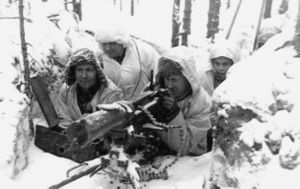
Several other countries, however, were drawn into the conflict at this time. By September 28, 1939, the three Baltic Republics felt they had no choice but to permit Soviet bases and troops on their territory. The Baltic Republics were occupied by the Soviet army in June 1940, and finally annexed to the Soviet Union in August 1940.
The Soviet Union wanted to annex Finland and offered a union agreement, but Finland rejected it and was invaded by the Soviets on November 30. This began the Winter War. After over three months of hard fighting, and heavy losses, the Soviet Union gave up the attempted invasion. In the Moscow Peace Treaty, March 12, 1940, Finland ceded 10% of her territory. The Finns were embittered over having lost more land in the peace than on the battle fields, and over the perceived lack of world sympathy.
War comes to the west
On May 10 the Phony War ended with a sweeping German invasion of Belgium, the Netherlands, Luxembourg, and French Third Republic that bypassed French fortifications along the Maginot Line. After overrunning Holland, Belgium, and Luxembourg, Germany turned against France, entering the country through the Ardennes on May 13—the French had made the fatal mistake of leaving this area almost totally undefended, believing its terrain to be impassable for tanks and other vehicles. Most Allied forces were in Flanders, anticipating a re-run of the World War I Schlieffen Plan, and were cut off from the French mainland. As a result of this, and also the superior German communications and tactics, the Battle of France was shorter than virtually all prewar Allied thought could have conceived. It lasted six weeks, including the Luftwaffe bombing of Paris June 3, after which France surrendered on June 22. In order to further the humiliation of the French people and the country itself, Hitler arranged for the surrender document to be signed in the same railway coach where the German surrender had been signed in 1918. The surrender divided France into two parts; the Northern part occupied by Germany, and a southern part under French control, based at Vichy and referred to as Vichy France, a rump state allied and friendly to Germany. Many French soldiers, as well as those of other occupied countries, escaped to Britain. The General de Gaulle proclaimed himself the legitimate leader of the Free French organization and vowed to continue to fight. On June 10 Italy declared war on both France and the United Kingdom.
Vyacheslav Molotov, the Foreign Policy Minister of the U.S.S.R., which was tied with Soviet-German non-aggression treaty, congratulated the Germans: "We hand over the most cordial congratulations by the Soviet government on the occasion of splendid success of German Wehrmacht. Guderian's tanks broke through to the sea near Abbeville, powered by Soviet fuel, the German bombs, that razed Rotterdam to the ground, were filled with Soviet pyroxylin, and bullet cases, which hit the British soldiers retreating from Dunkirk, were cast of Soviet cupronickel alloy..." [1]
Later, on April 24, 1941, the U.S.S.R. gave full diplomatic recognition to the Vichy government situated in the non-occupied zone in France.[1]
Thus, the fall of France left Britain and its Empire to stand alone. The British Prime Minister, Neville Chamberlain, resigned during the battle and was replaced by Winston Churchill. Fortunately for Britain, much of its army escaped capture from the northern French port of Dunkirk, where hundreds (if not thousands) of tiny civilian boats were used to ferry troops from the beaches to the waiting warships. There is much debate over whether German Panzer divisions could have defeated these soldiers alone if they had pressed forward, since the tank divisions were overextended and would require extensive refitting; in any case, Hitler elected to follow the advice of the leader of German air forces Hermann Göring and allow the Luftwaffe alone to attack the Allied forces until German infantry was able to advance, giving the British a window for the evacuation. Later, many of the evacuated troops would form an important part and the center of the army that landed at Normandy on D-Day.
The British rejected several covert German attempts to negotiate a peace. Germany massed their air force in northern German-occupied France to prepare the way for a possible invasion, codenamed Operation Seelöwe (Sea Lion), deeming that air superiority was essential for the invasion. The operations of the Luftwaffe against the Royal Air Force became known as the Battle of Britain. Initially the Luftwaffe concentrated on destroying the R.A.F. on the ground and in the air. They later switched to bombing major and large industrial British cities in the Blitz, in an attempt to draw R.A.F. fighters out and defeat them completely. Neither approach was successful in reducing the R.A.F. to the point where air superiority could be obtained, and plans for an invasion were suspended by September 1940.
During the Blitz, all of Britain's major industrial, cathderal, and political cites were heavily bombed. London suffered particularly, being bombed each night for several months. Other targets included Birmingham and Coventry, and strategically important cities, such as the naval base at Plymouth and the port of Kingston upon Hull. With no land forces in direct conflict in Europe, the war in the air attracted worldwide attention even as sea units fought the Battle of the Atlantic and a number of British commando raids hit targets in occupied Europe. Churchill famously said of the R.A.F. personnel who fought in the battle: "Never in the field of human conflict was so much owed by so many to so few".—
The war in the air
The air war in the European Theatre commenced in 1939, with U.S. Army Air Forces units being deployed to England to join the assault on Germany on July 4, 1942.
Prewar doctrine had held that waves of bombers hitting enemy cities would cause mass panic and the rapid collapse of the enemy. As a result, the Royal Air Force had built up a large strategic bomber force. By way of contrast, Nazi German air force doctrine was almost totally dedicated to supporting the army. Therefore, German bombers were smaller than their British equivalents, and Germany never developed a fully successful four engined heavy bomber equivalent to the Lancaster or B-17.
The main concentration of German raids on British cities was from September 7, 1940 until May 10, 1941. After that most of the strength of the Luftwaffe was diverted to the war against the Soviet Union. German raids continued on a smaller and less destructive scale for the rest of the war, and later the V1 Flying Bomb and V-2 ballistic missile were both used against Britain. However, the balance of bomb tonnage being dropped shifted greatly in favour of the RAF as Bomber Command gained in strength. By 1942, Bomber Command could put 1,000 bombers over one German city. From 1942 onwards, the efforts of Bomber Command were supplemented by the Eighth Air Force of the United States Army Air Forces. Bomber Command raided by night and the US forces by day. On February 14, 1945, a raid on Dresden produced one of the most devastating fires in history. A firestorm was created in the city, and between 18,000 to 25,000 people were killed.[2][3][4] Only the raids on Hamburg (July 24, 1943 – July 29, 1943), the March 9-10, 1945 firebombing of Tokyo and the nuclear attacks on Hiroshima (August 6, 1945) and Nagasaki (August 9, 1945) killed more people through a single attack.
The Mediterranean and Balkans
Italy had invaded Albania on April 7, 1939 and had officially annexed it. Mussolini's regime declared war on Britain and France on June 10, 1940, and invaded Greece on October 28. However, Italian forces were unable to match the Nazi successes in northwest Europe.
The Italian Regia Aeronautica began the long and unsuccessful siege of Malta on June 12. Even the surrender of France did not greatly assist the Axis forces. The naval Battle of the Mediterranean was a disaster for the Italian Regia Marina and the Vichy French navy, which were effectively destroyed as fighting forces by the Royal Navy and the Royal Australian Navy during 1940, most notably in the attack on Mers-el-Kebir (July 3) and the Battle of Taranto (November 11).
Not only did the Italians fail to conquer Greece, but under the supervision of Greece's dictator, Prime Minister Ioannis Metaxas, the Greeks successfully counterattacked into Albania, from November 14.
The Kingdom of Yugoslavia was lacking true leadership of a king and instead ruled by a regency headed by Prince Pavle Karađorđević, signed the Tripartite Treaty on March 25, 1941. The regency did this because they were promised by Hitler that if they joined and let the Axis attack Greece through their territory Yugoslavia would be given areas of Northern Greece including Salonika. However, soon afterwards, after public demonstrations, a March 27 coup d'état was made by Army General Dušan Simović which took control away from the regency and distanced Yugoslavia from the fascists.
The imminent Greek victory over Italy prompted German intervention. On April 6, 1941 German forces, supported by the Italians, Hungarians and the Bulgarians, engaged in combat with the Greeks and simultaneously invaded Yugoslavia. British, Australian and New Zealand forces were hastily dispatched from Egypt to Greece, but the Allies lacked a co-ordinated strategy, were comprehensively beaten and evacuated to Crete. Advancing rapidly, Axis forces captured Athens, Greece's capital on April 27, 1941 effectively placing most of the country under occupation.
After the mainland was conquered, Germany invaded Crete in what is known as the Battle of Crete (May 20, 1941 – June 1, 1941). Instead of an amphibious assault as expected, the Germans mounted a large airborne invasion. The paratroopers (Fallschirmjäger) suffered severe losses and large scale airborne operations were given up after that. However, the Germans eventually prevailed on Crete. Most of the Allied forces were evacuated to Egypt — joining King George II of Greece and the exiled Greek government of Emmanouil Tsouderos — on June 1, 1941.
Once the Balkans were secure, the largest land operation in history was launched, when Germany attacked the Soviet Union. The Balkans campaign delayed the invasion, and subsequent resistance movements in Albania, Yugoslavia and Greece tied up valuable Axis forces. This provided much needed and possibly decisive relief for the Soviets.
The Eastern Front
On June 22, 1941, Germany launched an invasion against the Soviet Union, code-named Operation Barbarossa[5]. This invasion, the biggest in recorded history, started the most bloody conflict the world has ever seen; the Axis-Soviet War. The Eastern Front was by far the largest and bloodiest theatre of World War II. It is generally accepted as being the costliest conflict in human history, with over 30 million dead as a result. It involved more land combat than all other World War II theatres combined. The distinctly brutal nature of warfare on the Eastern Front was exemplified by an often willful disregard for human life by both sides.
The leader of the USSR, Joseph Stalin, had been warned repeatedly by outside sources and his own intelligence network of the impending invasion, but he ignored the warnings due to conflicting information presented to him by the Soviet intelligence. Moreover, on the very night of the invasion Soviet troops received a directive undersigned by Marshal Timoshenko and General of the Army Georgi Zhukov that commanded: "do not answer to any provocations" and "do not undertake any actions without specific orders". The early weeks of the invasion were devastating for the Soviet Army. Enormous numbers of Soviet troops were encircled in pockets and fell into Nazi German hands. In addition to German troops, a few Italian, Hungarian and Romanian troops were also involved in the campaign. Finland also sent troops, but oddly, the Finns initially declared neutrality, however with both German and Soviet troops on her soil, Finland was well prepared to join forces with Germany when the Soviet Union attacked on June 25. The following conflict from 1941–1944 is sometimes referred to as the Continuation War, as in the continuation of the Winter War.
Operation Barbarossa suffered from several fundamental flaws. The most serious of these was the logistical situation of the attack. The sheer vastness of the distances in the Soviet Union meant that Germany could only advance so far before outrunning their supply chains. By the time the German attack froze to a halt before Moscow on December 5, 1941, it literally could not go any further. There simply were not enough supplies reaching the front to conduct proper defensive operations, let alone a proper offense. The timetable that Barbarossa was planned to assumed that the Soviets would collapse before the Russian winter hit. The failure of that to happen also fatally affected Nazi German plans. Had Hitler not invaded Greece and Yugoslavia earlier in the year, the invasion would have proceeded at that time, and the Soviet Union might have collapsed.
During their long retreat, the Soviets employed a scorched earth policy. They burnt crops and destroyed utilities as they withdrew before Germany. That helped to contribute to the logistical problems that Germany experienced. More importantly for them, the Soviets also succeeded in a massive and unprecedented removal of their industry from the threatened war zone to protected areas in the East.
The extension of the campaign beyond the length that Germany expected meant that the German Army suffered hundreds of thousands of casualties in the bitter cold of the Russian winter, and from the counterattacks of Soviet units.
Even with their advance having ground to a halt due to a lack of supplies and the onset of winter, Germany had conquered a vast amount of territory, including two-fifths of the Soviet economy. Dislodging them proved difficult and eventually cost the Soviet Union dearly.
A few months after the invasion began, German troops laid siege to Leningrad (known as the Siege of Leningrad) from the North by Finnish forces, and from the South by the German Wehrmacht. Finland's C-in-C Mannerheim had halted at the River Svir and refrained from attacking the city. Hitler had ordered that the city of Leningrad must "vanish from the surface of the earth", with its entire population exterminated. Rather than storming the city, the Wehrmacht was ordered to blockade Leningrad so as to starve the city to death, while attacking it with bombers and artillery. About one million civilians died in the Leningrad siege – 800,000 by starvation. It lasted 506 days. During the winter, the only way into the city was across Lake Ladoga, between the German and Finnish lines.

After enduring the winter of 1941–1942, the German army prepared for further offensive operations. One of the major problems faced by the Nazi war machine in World War II was a shortage of oil. For this reason, Germany decided to give up on Moscow for the time being, and the summer offensive of 1942 decided to focus on the war in the south, with the target being the oil fields of the Caucasus. In a major blunder, Hitler split Army Group South into two subgroups, Army Group A which would attack the Caucasus and army group B which would advance towards the city of Stalingrad (now Volgograd).
Indecision by Hitler, dissent among the higher ranked Nazi German officers, and extended supply lines combined in a prolonged battle in the streets of Stalingrad. Germany eventually occupied over 90% of the city, but in an attempt to defeat the remaining Soviet defenders almost all German soldiers in the area were funnelled into the ruins of the city. Months of bitter hand-to-hand combat in the ruins of the city depleted the German forces, leaving only weak Romanian and Hungarian forces to guard the flanks of the Stalingrad army group. In Operation Uranus, the Soviets easily defeated these minor axis forces as they performed an encirclement operation. The German troops remaining in the city were trapped – cut off from their supply lines and starving, they were ordered by Hitler to fight to the last man, and they displayed incredible fortitude and bravery under unbearable conditions.
Starved of food, fuel, ammunition, and clothes, the pocket was gradually reduced, with the last portion surrendering on February 2, 1943. In a cynical attempt to prevent the surrender, Hitler promoted Friedrich Paulus, Commander of 6th Army to Field Marshal, because no German of that rank had ever surrendered. Heavy losses affected both sides in the Battle of Stalingrad, one of the bloodiest battles in history. An estimated 1.5 million people perished in this battle, including 100,000 civilians in the city.
After Stalingrad, the initiative had passed from Germany but had not yet been seized by the Soviets. A desperate counterattack in the spring of 1943 by the forces of von Manstein temporarily halted the Soviet advance, and led to the largest tank battle in history, at Kursk. Kursk was the last major offensive by the German Army on the eastern front. The Soviets had intelligence of what was to come and prepared massive defences in huge depth in the Kursk salient. They stopped the German armoured thrusts after a maximum penetration of 17 miles (27 km). After Kursk the Red Army never ceased being on the offensive until Berlin was captured in May 1945.
More Soviet citizens died during World War II than those of all other countries combined. Nazi ideology considered Slavs to be "subhuman" and German forces committed ethnically targeted mass murder. Civilians were rounded up and burned alive or shot in squads in many cities conquered by the Nazis. Approximately 27 million Soviets, among them more than 20 million civilians in Soviet cities and areas, were killed in the Nazi invasion of the Soviet Union.
At least seven million Red Army troops died facing the Germans and their allies in the Eastern Front. The Axis forces themselves suffered over six million soldier deaths, whether by combat or by wounds, disease, starvation or exposure; another several hundred thousand were seized as POWs and over half died in Soviet gulags because of disease, starvation, or shortage of supplies.
Lend-Lease supplies from the United Kingdom and the United States made very important impact for Soviet military forces. Supply convoys sailed to Soviet ports that were patrolled by Nazi U-boats. Allied activities before D-Day may have tied up only a few divisions in actual fighting, but many more were forced to guard lonely coasts against raids that never came or to man antiaircraft guns throughout Europe.
Allied invasion of Italy
Successes in the North African desert left the Allies in complete control of the Mediterranean's southern shore and using this as a springboard Allied Forces Headquarters started to plan an attack into what Winston Churchill referred to as the "soft underbelly" of Europe.
The Allies first action was the capture of the island of Sicily, called Operation Husky, on July 10, 1943. This brought to the fore a growing dissatisfaction with Mussolini. On July 29, 1943, the King of Italy fired Mussolini, and placed him under house arrest in an isolated mountain resort. His replacement, General Pietro Badoglio, negotiated an armistice with the Allies on September 8, 1943. Germany moved quickly into the confused situation, disarming Italian formations, taking military control of Italian areas, and preparing to defend Italy on her own.
Allied troops landed on mainland southwestern Italy on September 3, 1943, crossing from Sicily. Further landings were made at Salerno and Taranto on September 9. For more information see: Allied invasion of Italy. This led Italy, already angry at its former leader Mussolini, to join the Western Allies.
A German commando raid Operation Eiche, led by Otto Skorzeny, rescued the imprisoned Mussolini. The Germans installed him as the "Head of State" and "Minister of Foreign Affairs" of a Nazi puppet state in northern Italy called the Italian Social Republic.
Germany had built a number of defensive lines through the mountains; the main one was called the Winter Line. The Allies came up against this in the winter of 1943 and were unable to break through. Amphibious landings at Anzio were made in an attempt to bypass the line: however the landing forces were contained by the Germans, and the Gustav Line (the core part of the Winter Line defences) remained intact. Finally, the line was broken in May 1944, in the fourth major attempt in four months to open the road to Rome dominated by the strategically positioned and historic Benedictine Abbey at Monte Cassino.
The Allies finally liberated Rome on June 4, 1944, two days before the landings in Normandy. Germany made a fighting withdrawal to the Gothic Line north of Florence. From September 10, 1944 till the end of the year Allied forces attacked the line and in some of the fiercest fighting of the war, broke the Gothic defences but failed to break through to the Lombardy Plain. The offensive by Allied and some Italian forces resumed when the weather permitted in early April 1945 and continued until Germany surrendered in Italy on April 29, 1945 two days after Mussolini's Allied capture and one day before Hitler's suicide.
Allied invasion of occupied France
Simultaneously with the fall of Rome came the long-awaited invasion of France. Operation Overlord put 3 million troops ashore in Normandy on June 6, 1944. A long grinding campaign two months long followed as American, British, Australian and Canadian forces were slowly built up in the bridgehead, and German forces slowly worn down. When the breakout finally did come it was spectacular, with American forces under Patton racing across France to Germany's border. The German forces that had been fighting in Normandy were trapped in the Falaise pocket.

Incessant bombing of Germany's infrastructure and cities caused tremendous casualties and disruption. Internally, Hitler survived a number of Nazi inner assassination attempts. The most serious was the July 20 Plot, occurring on July 20, 1944. Orchestrated by Claus von Stauffenberg and involving among others Erwin Rommel and Alfred Delp, the plot had intended to place a time bomb in a position to kill Hitler but a number of unscheduled factors and operation failures led to its failure. Hitler was only slightly injured.
Operation Overlord was complemented by an invasion of southern France on August 15, 1944 codenamed Operation Dragoon. By September 1944 three Allied Army Groups were in line against German formations in the west. There was optimism that the war in Europe might be over by the end of 1944.
An attempt was made to force the situation with Operation Market Garden (September 17, 1944 – September 24, 1944). The Allies attempted to capture bridges with an airborne assault, to open the way into Germany and liberate the northern Netherlands. Since heavier German forces than intelligence had predicted were present, the British 1st Airborne Division was almost completely destroyed.
The weather of 1944 combined with a poor situation for the Allies led to a stagnant situation on the western front. The Americans continued to grind away at the defenders in the Battle of Hurtgen Forest (September 13, 1944 – February 10, 1945). As long as Germany stayed on the defence, the Allies were hard-pressed to advance rapidly.
That changed when Germany mounted a major counteroffensive on December 16, 1944. The Ardennes offensive, also called the Battle of the Bulge, drove back and surrounded some small American units. The Allied forces were eventually successful in driving back Germany, in what turned out to be their last major advance of the war. The battle officially ended on January 27, 1945.
The final obstacle to the Allies was the Rhine. It was crossed in March 1945, and the way lay open to the center of Germany. The last major German forces in the west were encircled and trapped in the Ruhr.
End of the war in Europe

On April 27, 1945, as Allied forces closed in on Milan, Mussolini was captured by Italian Partisans. He was trying to flee Italy to Switzerland and was travelling with a German anti-air battalion. On April 28, Mussolini and several of the other Fascists captured with him were taken to Dongo and executed by squad shooting. The bodies were then taken to Milan and unceremoniously strung up in front of a filling station.
Hitler, learning of Mussolini's death, realised that the end had finally come. He remained in Berlin, the last Nazi held city and the crumbling Nazi Empire's capital, even as the city was encircled and trapped by the Soviets and the Battle of Berlin raged. On April 30, Adolf Hitler, with his wife of one day, Eva Braun, committed suicide in his bunker to avoid capture by Soviet troops. In his last will and testament, Hitler appointed Grand Admiral Karl Dönitz as the new German leader. But Germany lasted only 7 days longer under the "Flensburg government" of Dönitz. He surrendered unconditionally to the Americans, British, and Soviets on May 8, 1945 ("VE Day").
In late July and August 1945 the Potsdam Conference finally disbanded, denazified and demilitarized the former Nazi German state and reversed all German annexations and occupied territories.
See also
| Atlas of Battle Fronts from July 1943 to May 1945 at half-month intervals | ||
|---|---|---|
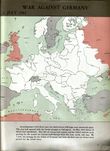 1943-07-01 |
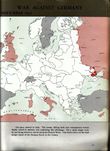 1943-11-01 |
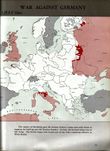 1944-07-01 |
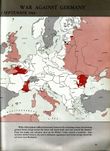 1944-09-01 |
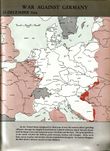 1944-12-01 |
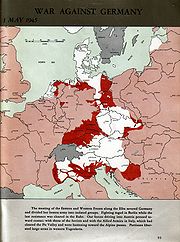 1945-05-01 |
- European-African-Middle Eastern Campaign Medal
- Mediterranean Theatre of Operations
- Pacific War
Citations and notes
- ↑ The Isolation of the Revolution
- ↑ Bojan Pancevski Dresden bombing death toll lower than thought, Daily Telegraph, 3 October 2008.
- ↑ Kate Connolly, Panel rethinks death toll from Dresden raids, The Guardian, 3 October 2008.
- ↑ Landeshauptstadt Dresden (1 October 2008). "Erklärung der Dresdner Historikerkommission zur Ermittlung der Opferzahlen der Luftangriffe auf die Stadt Dresden am 13./14. Februar 1945". Landeshauptstadt Dresden. http://www.dresden.de/media/pdf/presseamt/Erklaerung_Historikerkommission.pdf. Retrieved 13 February 2010.
- ↑ Amnon Sella. 'Barbarossa': Surprise Attack and Communication. Journal of Contemporary History, Vol. 13, No. 3, (Jul., 1978), pp. 555–583.
Further reading
- Churchill, Winston (1948–1953), The Second World War, 6 vols.
- Keegan, John (1989). The Second World War, Hutchinson. ISBN 0-09-174011-8.
- Lee, Loyd E. ed. World War II in Europe, Africa, and the Americas, with General Sources: A Handbook of Literature and Research (1997)
- Murray, Williamson and Millett, Allan R. (2000). A War to Be Won: Fighting the Second World War, Harvard University Press. ISBN 0-674-00163-X.
- Overy, Richard (1995). Why the Allies Won Pimlico. ISBN 0-7126-7453-5.
- Powaski, Ronald E. (2003). Lightning War: Blitzkrieg in the West, 1940. John Wiley. ISBN 0471394319, 9780471394310.
- Powaski, Ronald E. (2008). Lightning War: Blitzkrieg in the West, 1940. Book Sales, Inc.. ISBN 0785820973, 9780785820970.
- Smith, J. Douglas and Richard Jensen. (2002) World War II on the Web: A Guide to the Very Best Sites
- Weinberg, Gerhard L. (2005). A World at Arms: A Global History of World War II, Cambridge University Press. ISBN 0-521-44317-2.
|
|||||||||||||||||||||||||||||||||||||||
